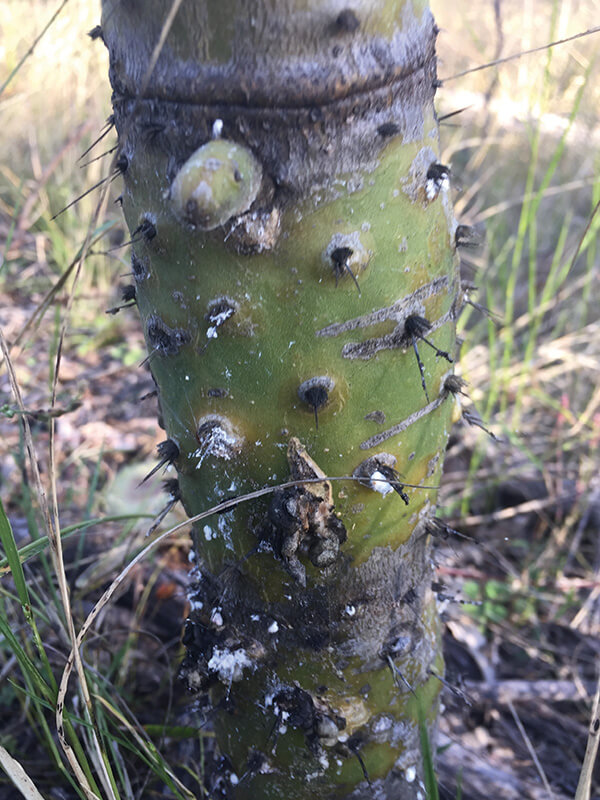Earlier this year I had the chance to see how Land for Wildlife landholders are successfully tackling the scourge of Velvety Tree Pear (Opuntia tomentosa) on two very different properties. Both landholders have tried various methods over the years and both have landed on the same method as the most effective and efficient.
Before I launch into describing hatchets and sauce bottles, it is worthwhile recounting the story of tree pear in Australia to understand why we are here today still fighting this weed.
Tree pear and other Opuntia species were primarily introduced to Australia to support the cochineal industry. Cochineals are a small, scale insect native to South America that feed on Opuntias and were harvested for their prized red dye that was used extensively in the clothing industry.
Opuntias were first cultivated in 1822 around Scone in NSW, and over the following decades they became established in the wild. By the 1920s, five species of Opuntia (collectively referred to as ‘prickly pear’) covered 25 million hectares in Queensland and were spreading at a rate of about 1 million hectares annually. The country was literally clogged with prickly pear. Ironically, a cochineal industry was never established in Australia.
Various government-led schemes were adopted in the early 1900s to control the prickly pear infestation including a bounty on Emus, currawongs and crows/ravens. The logic went along these lines: birds spread prickly pear, so let’s get rid of birds. Over a two-year period in the mid-1920s, over 200,000 birds were killed and 100,000 Emu eggs destroyed. Dangerous poisons like sulphuric acid and arsenic were also used, as was fire and mechanical removal, but none worked on the scale required.


It wasn’t until the release of the Cactoblastis Moth (Cactoblastis cactorum), a moth native to Argentina whose larva feed on Opuntia, in 1926 that the prickly pear infestation started to reduce. Within seven years, most of the prickly pear in Queensland was killed due to a moth.
Cochineals and Cactoblastis Moth larvae are still chewing away on prickly pear, but they will never eradicate it. So this is where landholders, modern herbicides and hatchets come into play.
The technique I am describing is very effective, but it takes a few weeks to months to fully kill a tree pear. Tools required include safety gear (e.g. chemical-resistant gloves, protective glasses, face mask and bushcare clothing), a sharp hatchet and either an old tomato sauce-type plastic bottle or a hand-held spray bottle. You may wish to add dye to the herbicide so that you can see where you have treated the plant. One landholder I visited uses straight glyphosate, the other uses straight Amitrol T. Both are approved herbicides for use on tree pear.
The trick is to make one angled cut into the tree pear so it holds the herbicide. Apply the herbicide straight after cutting. No need to cut too deep – just make sure the herbicide can get into the cambium layer allowing the plant to naturally distribute the herbicide throughout the tree. Circle the tree pear in cuts about half a metre off the ground, leaving about 10cm gap between each cut. You don’t want to ringbark the tree pear as that will make it collapse and the live leaf pads will sprout where they touch the ground.
Given that Cochineal and Cactoblastis Moth larvae prefer young tree pears, landholders generally target the large mature tree pears for herbicide control, leaving the young trees for the biocontrols. One landholder does not use herbicide on tree pear if there is a biocontrol agent within 30-50m of the plant. They also translocate ‘infected’ leaf pads to areas that don’t have biocontrol agents and this has proved very successful especially with Cochineal. Foliar spray is also occasionally used if a live tree pear falls over.
Tree pear is more common in the drier parts of SEQ and some Land for Wildlife members are making remarkable progress on controlling infestations of tree pear using this technique. If you wish to know more about tree pear control, please have a chat with your Land for Wildlife Officer.
Article and photos by
Deborah Metters




